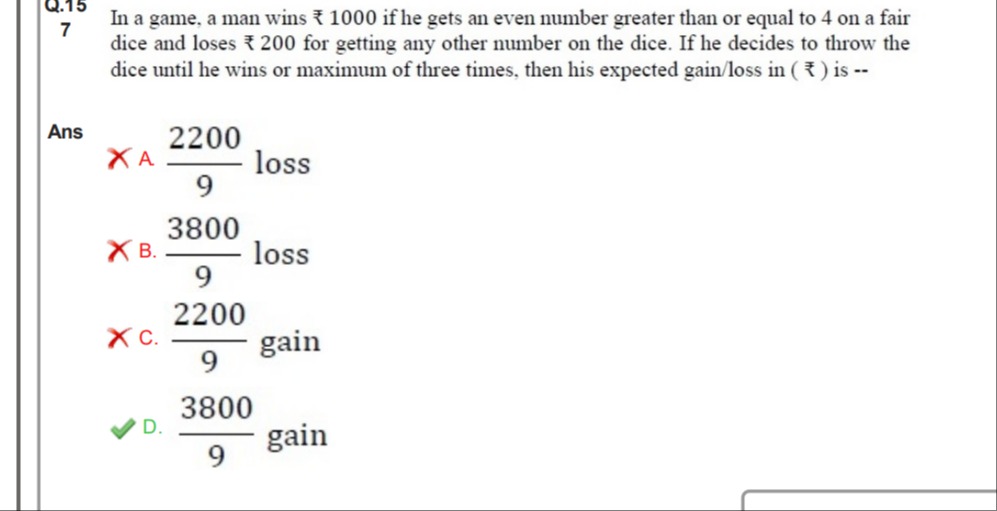Question
Question: In a game, a man wins ₹ 1000 if he gets an even number greater than or equal to 4 on a fair dice and...
In a game, a man wins ₹ 1000 if he gets an even number greater than or equal to 4 on a fair dice and loses ₹ 200 for getting any other number on the dice. If he decides to throw the dice until he wins or maximum of three times, then his expected gain/loss in (₹) is --

92200loss
93800loss
92200gain
93800gain
93800 gain
Solution
To calculate the expected gain/loss, we need to consider all possible scenarios for the game and their respective probabilities and net gains/losses.
1. Determine probabilities for a single throw:
A fair die has 6 outcomes: {1, 2, 3, 4, 5, 6}.
Winning condition: An even number greater than or equal to 4. These numbers are {4, 6}.
Number of winning outcomes = 2.
Probability of winning on a single throw (PW) = 2/6 = 1/3.
Losing condition: Any other number. These numbers are {1, 2, 3, 5}.
Number of losing outcomes = 4.
Probability of losing on a single throw (PL) = 4/6 = 2/3.
(Note: PW+PL = 1/3 + 2/3 = 1)
2. Define gain/loss amounts:
- If he wins, he gains ₹ 1000.
- If he loses, he loses ₹ 200.
3. Analyze scenarios based on the maximum of three throws:
-
Scenario 1: Wins on the 1st throw (W1)
- Probability: P(W1) = PW = 1/3
- Net Gain: ₹ 1000
- Contribution to Expected Value: (1/3) * 1000 = 1000/3
-
Scenario 2: Loses on the 1st throw, Wins on the 2nd throw (L1W2)
- Probability: P(L1W2) = PL∗PW = (2/3) * (1/3) = 2/9
- Net Gain: -₹ 200 (from 1st throw) + ₹ 1000 (from 2nd throw) = ₹ 800
- Contribution to Expected Value: (2/9) * 800 = 1600/9
-
Scenario 3: Loses on the 1st, Loses on the 2nd, Wins on the 3rd throw (L1L2W3)
- Probability: P(L1L2W3) = PL∗PL∗PW = (2/3) * (2/3) * (1/3) = 4/27
- Net Gain: -₹ 200 (from 1st) - ₹ 200 (from 2nd) + ₹ 1000 (from 3rd) = ₹ 600
- Contribution to Expected Value: (4/27) * 600 = 2400/27
-
Scenario 4: Loses on the 1st, Loses on the 2nd, Loses on the 3rd throw (L1L2L3)
- This is the case where he reaches the maximum three throws without winning.
- Probability: P(L1L2L3) = PL∗PL∗PL = (2/3) * (2/3) * (2/3) = 8/27
- Net Gain: -₹ 200 (from 1st) - ₹ 200 (from 2nd) - ₹ 200 (from 3rd) = -₹ 600 (a loss of ₹ 600)
- Contribution to Expected Value: (8/27) * (-600) = -4800/27
4. Calculate the Total Expected Gain/Loss:
Expected Value (E) = Sum of contributions from all scenarios
E=31000+91600+272400+(−274800)
To sum these fractions, find a common denominator, which is 27:
E=271000×9+271600×3+272400−274800
E=279000+274800+272400−274800
E=279000+4800+2400−4800
E=279000+2400
E=2711400
Simplify the fraction by dividing both numerator and denominator by 3:
E=27÷311400÷3
E=93800
Since the expected value is positive, it represents a gain.
